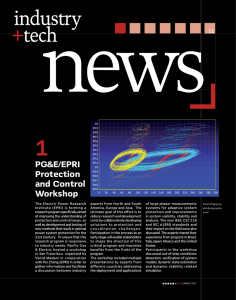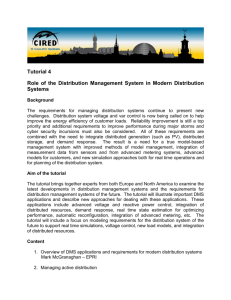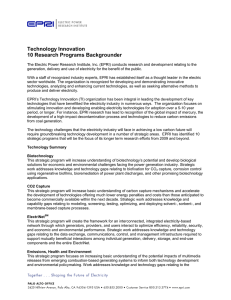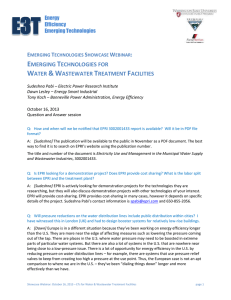Strategic Technology Research Backgrounder Renewables
advertisement
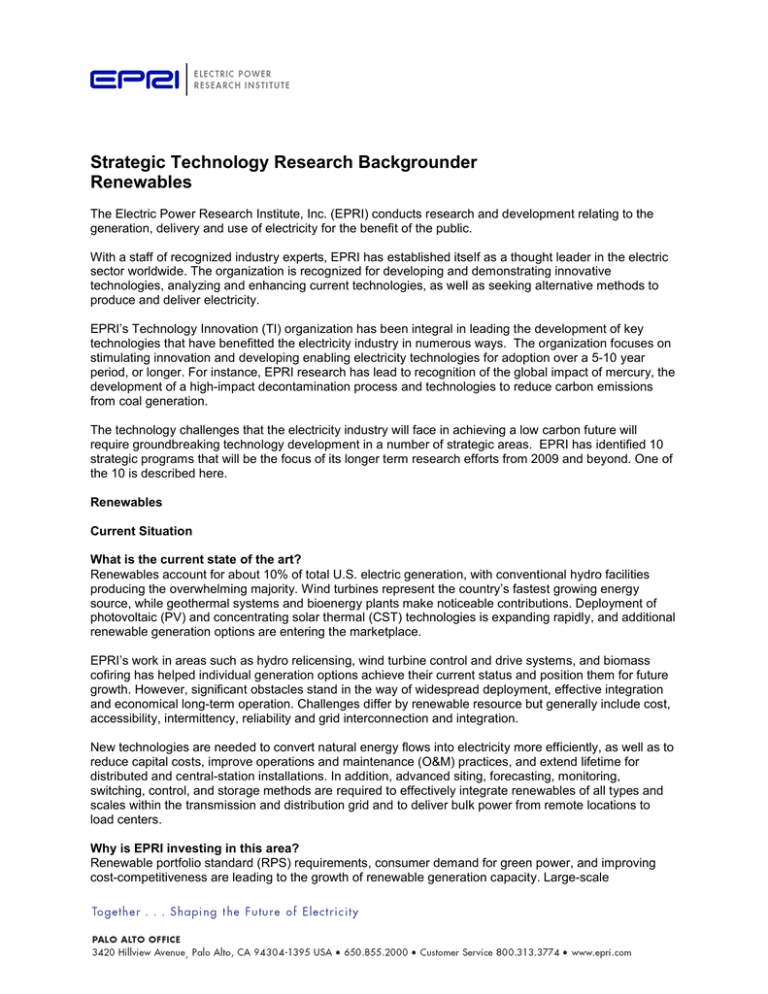
Strategic Technology Research Backgrounder Renewables The Electric Power Research Institute, Inc. (EPRI) conducts research and development relating to the generation, delivery and use of electricity for the benefit of the public. With a staff of recognized industry experts, EPRI has established itself as a thought leader in the electric sector worldwide. The organization is recognized for developing and demonstrating innovative technologies, analyzing and enhancing current technologies, as well as seeking alternative methods to produce and deliver electricity. EPRI’s Technology Innovation (TI) organization has been integral in leading the development of key technologies that have benefitted the electricity industry in numerous ways. The organization focuses on stimulating innovation and developing enabling electricity technologies for adoption over a 5-10 year period, or longer. For instance, EPRI research has lead to recognition of the global impact of mercury, the development of a high-impact decontamination process and technologies to reduce carbon emissions from coal generation. The technology challenges that the electricity industry will face in achieving a low carbon future will require groundbreaking technology development in a number of strategic areas. EPRI has identified 10 strategic programs that will be the focus of its longer term research efforts from 2009 and beyond. One of the 10 is described here. Renewables Current Situation What is the current state of the art? Renewables account for about 10% of total U.S. electric generation, with conventional hydro facilities producing the overwhelming majority. Wind turbines represent the country’s fastest growing energy source, while geothermal systems and bioenergy plants make noticeable contributions. Deployment of photovoltaic (PV) and concentrating solar thermal (CST) technologies is expanding rapidly, and additional renewable generation options are entering the marketplace. EPRI’s work in areas such as hydro relicensing, wind turbine control and drive systems, and biomass cofiring has helped individual generation options achieve their current status and position them for future growth. However, significant obstacles stand in the way of widespread deployment, effective integration and economical long-term operation. Challenges differ by renewable resource but generally include cost, accessibility, intermittency, reliability and grid interconnection and integration. New technologies are needed to convert natural energy flows into electricity more efficiently, as well as to reduce capital costs, improve operations and maintenance (O&M) practices, and extend lifetime for distributed and central-station installations. In addition, advanced siting, forecasting, monitoring, switching, control, and storage methods are required to effectively integrate renewables of all types and scales within the transmission and distribution grid and to deliver bulk power from remote locations to load centers. Why is EPRI investing in this area? Renewable portfolio standard (RPS) requirements, consumer demand for green power, and improving cost-competitiveness are leading to the growth of renewable generation capacity. Large-scale deployment of wind, bioenergy, solar and other technologies is anticipated in the coming decades in response to concerns relating to energy security, fuel price volatility and climate change. By developing new life assessment, failure prevention and energy conversion methods, EPRI hopes to improve the cost-performance characteristics of existing and new renewable generation options. Power producers may be able to reduce the economic impact associated with diversifying supply portfolios, achieving RPS targets and cutting CO2 emissions. EPRI also seek to create the knowledge and technologies required to accommodate—and optimize the value of—growing amounts of renewable energy capacity at customer sites and in resource-abundant locations. Improved integration capabilities could help to match intermittent energy production with demand on both geographic and temporal scales and to maintain grid reliability and security even at high levels of deployment. The Opportunity What are the potential superior innovations? PV technologies offering very high efficiency could transform the electricity sector by delivering on-site energy at costs competitive with retail prices and by supplying bulk power at costs comparable to centralstation fossil and nuclear generation options. New nondestructive evaluation (NDE) techniques could prevent premature failure of wind turbine, geothermal piping, and other critical components. Development of a renewable energy technology strategy is expected to identify additional R&D opportunities with highpayoff potential. How could this research change the industry? Commercial flat-plate PV systems being deployed today have efficiencies ranging from about 10% to nearly 20%, depending on brand and cost. Third-generation PV devices offering two to four times higher efficiency and other advanced renewable energy technologies could support the electricity sector’s efforts to achieve RPS targets and cut greenhouse gas emissions at lower costs. They may also help to improve energy security by reducing vulnerability to supply disruptions and fuel price volatility. Advanced NDE methods for critical components may allow power producers to assess the condition of inservice equipment, optimize O&M practices, and extend lifetimes. This could enable reliable long-term operation of existing renewable capacity while decreasing reliance on original equipment manufacturers. In addition, it could reduce risk for future investments in renewable generation. New grid integration technologies may make interconnection easier and less costly while maintaining system performance and service reliability. They also could endow the grid with improved power handling and control capabilities, facilitate power market access for owners of distributed and large-scale installations, and create business opportunities for electricity providers. What other applications are possible? Advanced renewable generation and integration technologies may help transform how energy is supplied to and purchased by residential, commercial, and industrial consumers. These advances could also revolutionize the building supply and construction industries, with clean and intelligent energy technologies integrated in the design of roofing, cladding, window, and other systems. The Program How are innovations being developed? 2 In the “High-Efficiency PV Research Project,” EPRI, EdF, and European agencies are supporting exploratory work by a consortium of 20 international laboratories and universities. Initial research, started in 2007, involves development and application of models and laboratory assemblies to assess spectrum matching (both splitting and shifting), multilevel absorption, and thermoelectric concepts. The goal is to identify advanced PV materials and structures with potential to achieve energy conversion efficiencies exceeding 40% in commercial devices. Results to date indicate that state-of-the-art spectrum-shifting technology—involving the use of novel optical coatings to adjust photon energy levels to increase the fraction that may be converted into electricity—offers the most promise for rapid progress. In fact, a new class of materials has been discovered with prospective near-term application via very efficient up-conversion of infrared photons to better match the solar spectrum to conventional silicon PV cells. Focused studies are under way on the possibility for an efficiency gain of at least 1% from today’s workhorse PV materials as exploratory research continues on all third-generation PV technologies. For the highest-potential options, proof-ofconcept device development and testing are scheduled to begin in 2011. EPRI is taking a leading role in the development of new NDE techniques for wind turbine blades, geothermal piping and other critical components. Non-intrusive, easily deployed NDE methods will help power producers assess the condition of in-service equipment without reducing capacity factor, helping them save money while securing the data required to optimize operations and maintenance practices and extend lifetimes. Turbine blade NDE methods are being pursued first by screening techniques developed for aerospace and other applications, including shearography and digital image correlation. Promising methods will be evaluated using test specimens collected from turbine blade manufacturers and vendors. NDE technologies for detection of scaling and corrosion in geothermal system piping also are being developed. EPRI is partnering with the American Council on Renewable Energy to create a technology strategy identifying the near-, mid-, and long-term research, development, demonstration, and deployment (RDD&D) priorities to expand the role of renewables in meeting energy needs and objectives at national and global levels. A discussion draft of Growing Renewable Energy: Technology Strategy for Improving Security, Creating Jobs & Reducing Emissions was released at the RETECH 2009 conference in late February. The strategy defined within this roadmap document will inform future RDD&D investments by EPRI and the public and private sectors. When will applications occur? Because strategic research is inherently risky, the renewable energy technology innovations being pursued by EPRI will pan out over uncertain time frames. Field-deployable NDE technologies for wind turbine blades are expected within five years. Preliminary EPRI research may yield substantial increases in the efficiency of today’s PV technologies over the same time frame, while commercial devices based on third-generation PV technology are anticipated within a decade. Value What are anticipated costs and benefits? Potential societal benefits associated with accelerating widespread deployment of high-efficiency renewable generation technologies and commercial application of NDE methods and other improved asset management techniques total in the billions of dollars. Not only could these innovations reduce the industry-wide costs and risks of meeting RPS and climate policy objectives, they could also help to improve energy security by reducing vulnerability to supply disruptions and fuel price volatility. 3 About EPRI The Electric Power Research Institute, Inc. (EPRI, www.epri.com) conducts research and development relating to the generation, delivery and use of electricity for the benefit of the public. An independent, nonprofit organization, EPRI brings together experts from academia and industry as well as its own scientists and engineers to help address challenges in electricity generation, delivery and use, including health, safety and the environment. EPRI's members represent more than 90 percent of the electricity generated and delivered in the United States, and international participation extends to 40 countries. EPRI's principal offices and laboratories are located in Palo Alto, Calif.; Charlotte, N.C.; Knoxville, Tenn.; and Lenox, Mass. ### Contact: Don Kintner EPRI Manager, Communications dkintner@epri.com 704-595-2006 4
